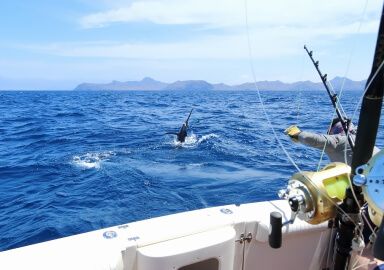Mutton Snapper
A typical snapper, with an almond-shaped body, large mouth and camouflage stripes that appear only when the fish is at rest, the mutton snapper is a popular object of reef fishing in the Atlantic
View 22 listings
22
listings
–
price starting from
5
countries
Where and When?
Inshore waters down the eastern seaboard of the Americas from Massachusetts, in the north, to Brazil, in the south, are home to the mutton snapper. It is less common in the extremities of its range but common in the “core areas” around Florida, the Gulf of Mexico and the Caribbean Sea. The best place to find and catch mutton snappers changes with the size of the fish and, after most of the juvenile fish gravitate shorewards after spawning, small specimens may be found in estuaries, lagoons, salt marshes, mangroves and seagrass beds. As they grow they generally move towards deeper waters where they congregate around structures such as reefs, wrecks and piers or similar objects. Adult fish are usually caught in fairly clear water and within the depth range of 25 to 95 meters (82 to 312 ft.) and they are nearly always closely associated with some form of natural or artificial structure. They are generally a “bottom associated” fish and usually have a default area into which they can withdraw if threatened. Mutton snappers may be caught throughout the year, particularly in the more tropical areas, but in the extremes of their range they are usually a summer species.
About Mutton Snapper
The mutton snapper (Lutjanus analis) is a “typical” snapper and has the “standard” almond-shaped body, large mouth with strong, sharp, conical teeth and the “snapper” dark spot below the dorsal fin. Their eyes are fairly small and the forward dorsal fin has a set of sharp spines while the rear dorsal fin has soft rays. Mutton snapper are olive green to black along the back and upper flanks and this becomes more reddish down the sides. When resting, their colour is often more camouflaged, with 10 to 12 dark vertical bars down the sides which quickly change when the fish is aroused. Juvenile fish are lighter in colour, with yellowish-brown bands and almost clear fins. Mutton snapper spawn around reefs but there are several important areas, known locally, where, at the same time each year, large specimens congregate to spawn. The species grows to a maximum recorded length of 94 cm (37 in.) but fish of around 50 cm (20 in.) are much more common. The heaviest specimen recorded was 15.6 kg (34 lbs.) and the greatest age has been estimated at 40 years.
How to Catch?
Tackle and tactics for this species depend on what size fish are targeted and where they are. For shore and small boat fishing in estuaries and lagoons light tackle may be appropriate but, as the target increases in size and the depth grows, heavier tackle and more care is required. Most large fish are caught from boats using a variety of tackle and baits but the most popular, depending mostly on the depth of the water, are various forms of live baiting. Casting a live bait in shallow water, using a circle hook, can be successful but the species appears wary of taking bait and mutton snapper are sensitive to “feeling” tackle and so bait must be carefully hooked and light tackle used if possible. In fairly shallow water lowering a bag of chum may bring fish closer to the boat. Once a large mutton snapper knows it has been hooked a memorable fight is likely to follow.
Listing Types
Similar Species
 Black Snapper
3 offers
Black Snapper
3 offers
 Blackfin Snapper
2 offers
Blackfin Snapper
2 offers
 Cubera Snapper
30 offers
Cubera Snapper
30 offers
 Gray Snapper
5 offers
Gray Snapper
5 offers
 Lane Snapper
14 offers
Lane Snapper
14 offers
 Mangrove Snapper
42 offers
Mangrove Snapper
42 offers
 Mohogany Snapper
1 offer
Mohogany Snapper
1 offer
 Mullet Snapper
6 offers
Mullet Snapper
6 offers
 Pink Snapper
2 offers
Pink Snapper
2 offers
 Queen Snapper
6 offers
Queen Snapper
6 offers
 Red Emperor Snapper
7 offers
Red Emperor Snapper
7 offers
 Red Snapper
99 offers
Red Snapper
99 offers
 Short-Tail Red Snapper
1 offer
Short-Tail Red Snapper
1 offer
 Silk Snapper
3 offers
Silk Snapper
3 offers
 Snapper
275 offers
Snapper
275 offers
 Vermilion Snapper
13 offers
Vermilion Snapper
13 offers
 Yellowtail Snapper
24 offers
Yellowtail Snapper
24 offers







